Those of you who know me know I love Korean (and other Asian) food series. Not series in the sense of something like Chef’s Table that are looking at actual chefs or restaurants or ingredients, but drama series that revolve around kitchens. There’s invariably a romance involved, often gangsters of some sort. There’s a whole industry of these types of shows on Korean TV in particular. Taiwan comes in a close second. Japan has some great ones too. China tends more towards movies than TV series, but I love those too. And even sometimes ones that don’t revolve around food. I’ll give you a list of favorites at the end of this post – many of which are available on Netflix or other easy access sources – I tend to watch a lot of mine on Viki, which is a site dedicated to Asian TV series – you can usually watch the first few episodes of any series for free, but an account is required for more. It costs. A whopping 99¢ a month.
So, the latest series I’m watching is sort of a modern sequel to a very famous one. The original, Dae Jang Geum, is considered a classic of the genre, and is set in ancient Korea following the life of a woman who was born with senses and abilities related to food that were supranatural. The new version is set in modern day Korea, and is called Jang Geum, Oh My Grandma, and follows a trio of siblings who are her descendants, many generations on, who have each inherited one of her abilities, and have to work together. I was thawing out a whole chicken to make for the next day’s dinner for us, and it happened that in the episode I was watching, one of them took on making what looked to be a very delicious chicken dish. And, away we go with my “inspired” (didn’t have all the right ingredients) version of Dak Dori Tang, literally something like “Duty Chicken Soup”. Korean Jewish penicillin?
Step one – cut up the chicken into serving pieces – for us that’s separate legs, thighs, wings, and cutting the breast into quarters and the back in half (not a lot of meat on the back, but it adds flavor to the soup) – so we end up with twelve pieces. Fill a pot with cold water, drop in a couple of green tea bags and some crushed garlic cloves. Put the chicken pieces in, and put it in the refrigerator to steep for a few hours.
Now, there are, as with any sort of stew, a variety of different vegetables that might make their appearance. Onions and carrots seem to be a must. Most of the recipes in included potato, but some used sweet potato or yam. Some used squash. Most used daikon. I used what we had – onions, carrots, and a squash. I could have added potatoes, but we’ve been eating so many that I just wanted a break. I would imagine, if you went as classic as possible, it’d probably be onions, carrots, potatoes, and daikon.
The spice blend – 3 tablespoons of gochujang, Korean chili paste; 2 tablespoons of gochugaru, Korean chili flakes (I didn’t have any in house, so I used local chili flakes); 2 tablespoons of rice wine and 2 of soy sauce; 1 tablespoon of sugar; 2 cloves of garlic, grated; the same amount of ginger, also grated; 1 teaspoon of sesame oil, 1 teaspoon of black pepper.
Mix them altogether well. In reality, this is an unnecessary move, since it’s just going to get dumped into the soup, but aesthetically it feels like the right thing to do. I’ve seen a couple of recipes where they rub the chicken all over with this spice paste before dropping it in the water for the soup, but that seems a bit silly, unless you’re going to do something like brown the chicken with the paste on, or marinate it for awhile in the paste, which none of the recipes called for.
Chop up the vegetables into bite sized pieces.
Drain the chicken, put it in a pot big enough to hold the whole stew (that’s the chicken and all the vegetables). Cover with water and a handful of coarse salt, and…
…bring to a boil. Let boil for only about one minute once it starts actually boiling. You’ve all probably cooked a chicken (or other meat) soup or stew and there’s always that “scum” that comes to the surface that they tell you to skim off. The Korean take is simply let the scum come to the surface, and then dump it. Which is exactly what we do – after that one minute, simply drain the pot, letting all that scum, whatever blood the salt has helped draw out, and some of the fat that renders, down the drain.
Return the chicken to the pot, along with the spice mixture, and top with water that just barely covers the chicken. Bring to a boil, reduce the heat down to medium, and let simmer for ten minutes.
Add the vegetables, bring back to a boil over high heat again, reduce the heat back to medium, and let simmer, pushing the vegetables down into the broth now and again – they’ll all end up fitting, it just takes a few minutes until it all settles into place. Keep at a high simmer, or even a low boil, to both cook the vegetables and chicken through, but also to reduce down the liquid. Let it go for about twenty minutes once it starts to boil. Even thirty, though the vegetables, depending on what you used, may start to get too mushy if you do that. Judgement call.
During the last five minutes, toss in a handful of chopped cilantro and/or parsley. Some recipes use chopped perrilla/shiso leaves to give it a really aromatic character. I didn’t have any.
Garnish with slivered green onions and toasted sesame seeds.
Serve with rice, and that’s dinner! Koreans would probably serve this as a bowl of soup, with a separate bowl of rice on the side to either eat separately, or some people mix it into the soup. We just ladled extra broth into the bowl which is being soaked up by the rice from below.
Okay, as promised above, some favorite Korean TV series…
Let’s start with non-food related… two favorites for people into online gaming… Memories of Alhambra and The King’s Avatar. The former is a story of a guy who buys the rights to an online game and finds himself in the world of that game, trying to rescue the creator, who’s become trapped there. The second follows the rise, fall, and rise again of a top “professional gamer”. Both have some pretty amazing in-game graphic sequences. Both are currently available on Netflix.
In the romance and action world, which seem to be inextricably intertwined, Cinderella and the Four Knights, a young woman caught up in a family intrigue between brothers (on Netflix); and Goodbye, Mr. Black, a sort of spy thriller, which was available on Netflix, but at least here in Argentina isn’t at the moment, though it may be wherever you are (it is available on Viki). Good Doctor is the original series that inspired the US’ tv drama The Good Doctor. The storyline starts similar – a young man with autism who has worked his way through medical school, and starts with his first day of residency. It diverges quickly after that, and only lasted one season. I have to admit, the US version is the better of the two, though I saw this one long before that, and loved it then (on Viki).
Okay, let’s jump to food…
Let’s Eat and Let’s Eat 2 – easily the most mouthwatering of them all, following the adventures of a foodie with an online following for his quirky restaurant reviews. There’s a lot of “food porn”. There’s romance, of course. Both seasons available on Netflix. If you were only going to watch one series, it should be this one. Also a great starting point for the genre.
Dae Jang Geum, or Jewel in the Palace – the aforementioned historical drama that started this post. It was available on Viki, but currently isn’t. Not sure where you could find it right now, but I’m sure it’s out there.
Kimchi Family – a “retired” gangster finds himself at a country inn, where he feels he has a childhood connection that he can’t quite recall from his pre-orphanage days. Drama, police, romance, and more types of kimchi than you knew existed – each episode features one. Also a close second for absolutely mouthwatering food. On Viki.
Panda and Hedgehog – if you like pastries, this one’s for you. Set in and around a hole-in-the-wall pastry shop that’s turning out some pretty special stuff. Romance and corporate intrigue enter the scene. On both Netflix and Viki.
Late Night Restaurant – the Korean version of Midnight Diner, a Japanese series, both based on a Japanese manga series of books. Life in a restaurant that’s only open during the night. Quirky, and fun, and good home cooking. Both the Korean and Japanese shows are well worth enjoying. The Korean one is on Viki, the Japanese one on Netflix.
Coffee Prince – if you like coffee and cafes, this drama set around a young man’s dream of opening the perfect cafe is for you. On Viki.
Wok of Love – not surprisingly, given the title, it’s kind of a romance – though a three sided one in a professional kitchen. On Viki.
Drinking Solo – for those of you into cocktails and other beverages, follow this guy and his friends through his dining and drinking adventures. On Viki.
Best Chicken – it’s all about Korean fried chicken. And a bathhouse. And romance. And redemption. It gets a little “beyond silly” at moments, but was fun. On Viki.
There are plenty more, but this is a good representative sampling, and some of my favorites.
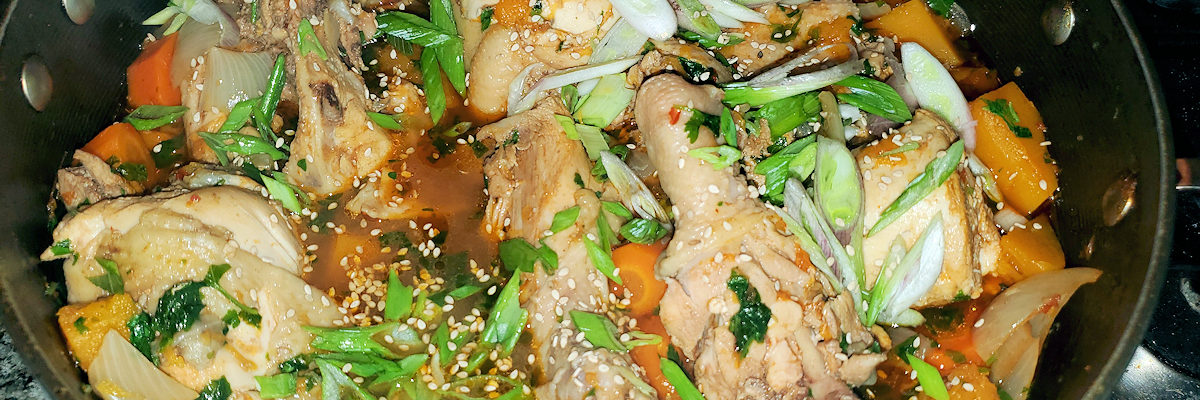
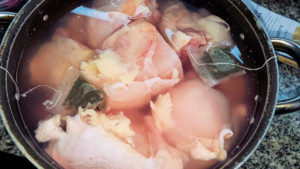
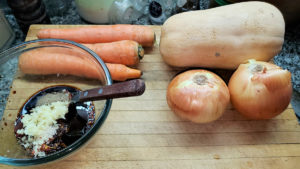
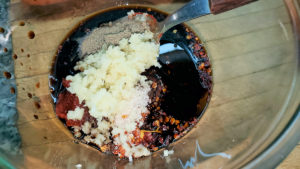
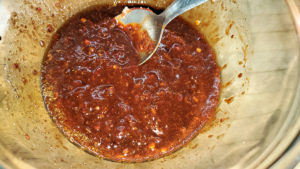
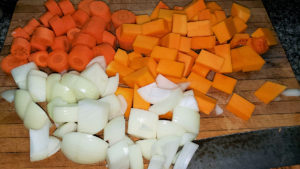
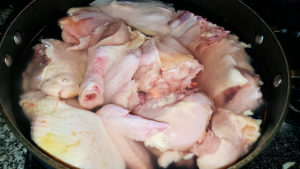
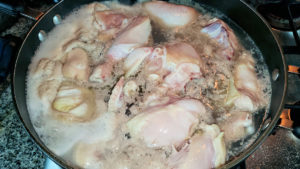
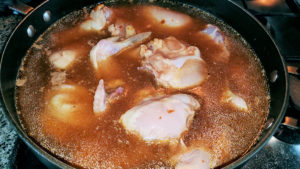
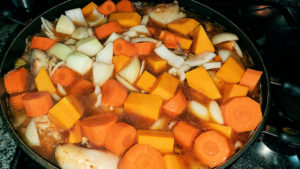
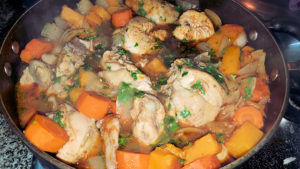
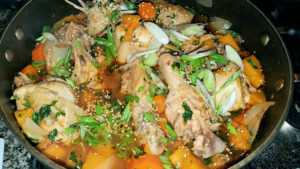
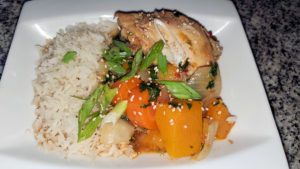
Hey Dan. Curious, What are the green tea bags for? Thanks T/
Not sure – I was just following the recipe. But, as a guess, some of it may be flavoring, but most of it is probably that the tannins in the tea help draw out or neutralize some of the “schmutz” for lack of a better term. I have noted a propensity in Korean recipes and in the food dramas to “remove the strong flavors of the meat” for various meats, almost like they want to neutralize the meat flavors and just focus on the sauces and condiments. But that’s all just speculation.